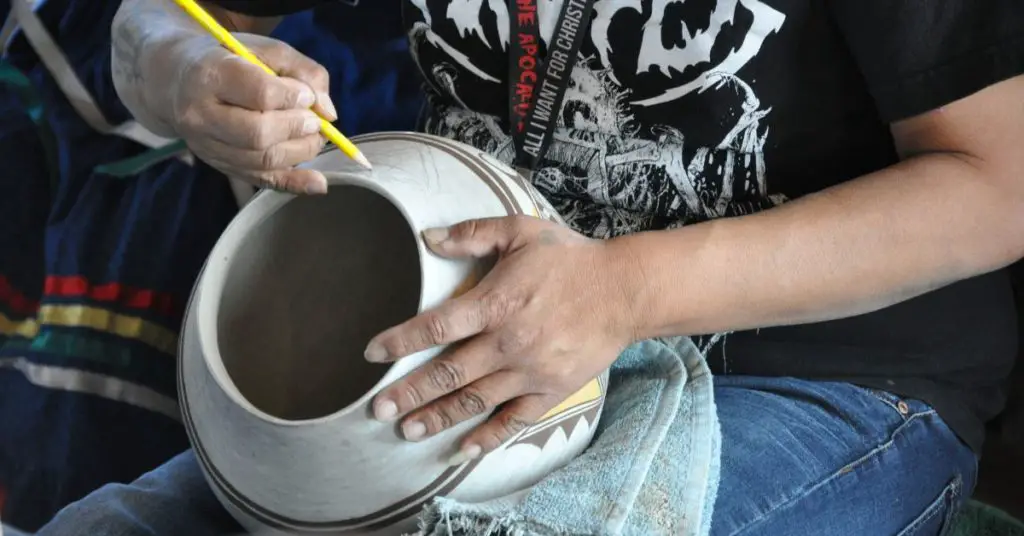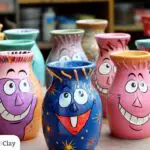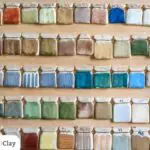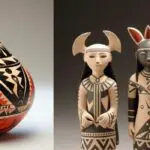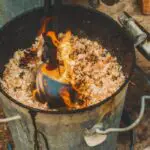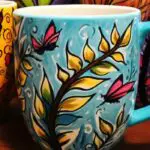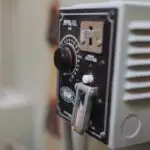The Navajo people have a deep history of being great artisans and craftsmen. So today, we’re telling the story of Navajo pottery through the different and brilliant styles.
Number 8 is worth seeing!
1. Navajo Etched Pottery
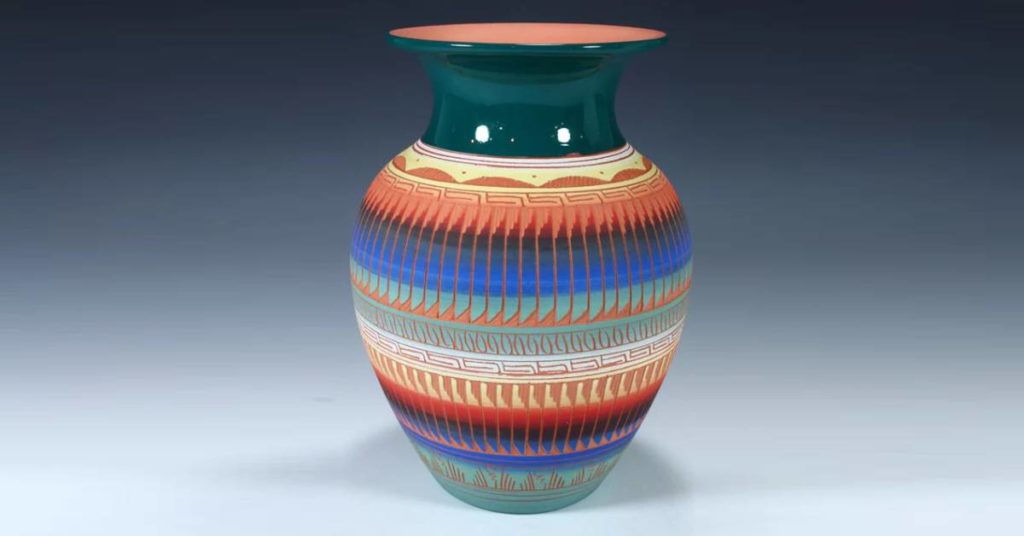
The bright color and intricate designs demonstrated in the pictured piece have become synonymous with Navajo pottery. The piece was poured from a mold. The potter then uses a wheel to paint the piece. That’s how the paint is added around the edges in bands. The artist hand etches a design into the surface and the pot is fired.
Though not traditional Navajo pottery, the style is incredibly popular with consumers. Navajo pottery artists have begun to make it larger quantities.
2. Navajo Hand Etched Horsehair Pottery
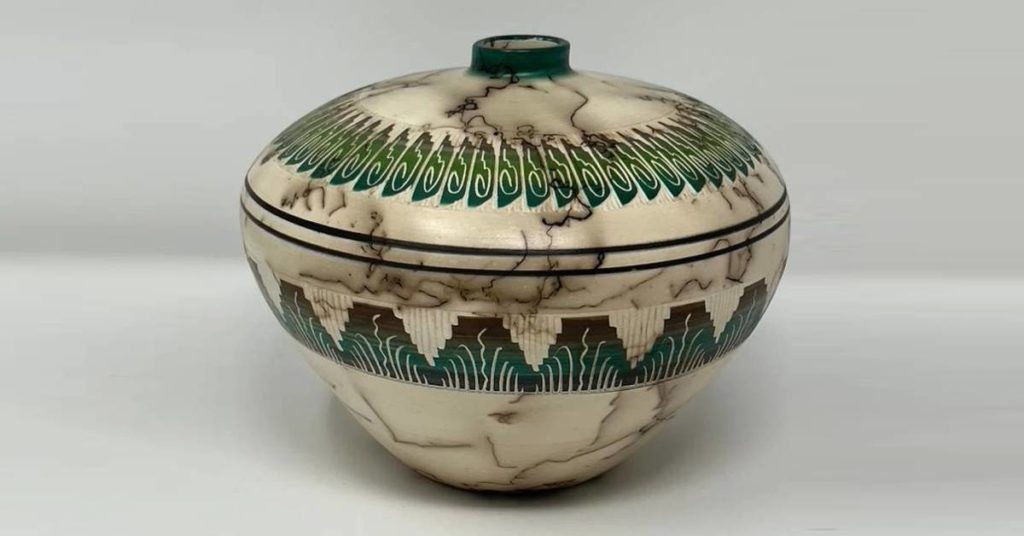
One of the Navajo traditional designs incorporates horsehair into the decoration of a pot. A potter takes hair from a horses tail or mane. The hair is laid across the pottery pieces in different designs and patterns at the bisque stage of clay. Then the piece is fired using a technique that is similar to raku firing.
Here’s a cool video showing the technique from Potter Simon Thorborn.
If you want to learn more about raku firing, check out our article what is raku pottery?
3. Navajo Wedding Vase
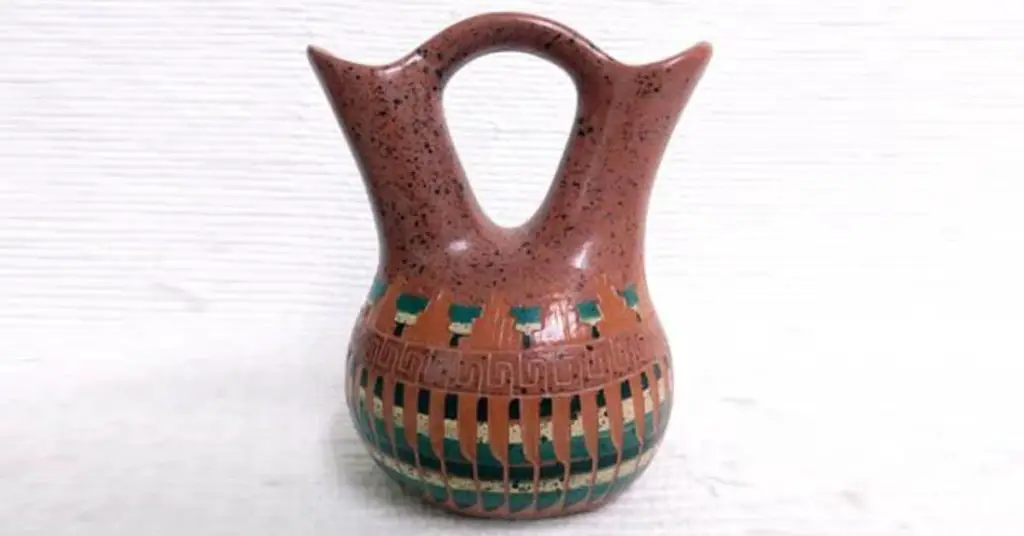
In addition to utilitarian water jars and food storage, many pieces had a ceremonial use. The vase pictured above was made specifically for the wedding ceremony. The two-headed vase is a distinctive pottery style of the tribes whose ancestors settled in the Southwest of the United States. Wedding vases are among the early Navajo pottery discovered by archeologists.
In a traditional ceremony, the wedding couple drank a concoction from the vase made from the spouts. The ceremony represented the blending of their lives.
The pictured piece is a beautifully etched vase with southwestern desert colors. The piece was crafted by ceramic artist Elaine Begay.
4. Coiled Pine Pitch Carved Pottery

The pictured piece was made by artist Lorraine Williams.
Pine pitch is a type of pottery created in a process where a towel is dipped in boiling water and applied to the surface of the pot. Pine pitch is a traditional pottery style from the Navajo people and surrounding communities. There is a functional aspect to pine pitch pottery and a decorative aspect to pine pitch pottery.
- The functional: The boiling water vitrifies the piece and makes it food safe.
- The decorative: The process also adds a glossy finish to the piece. Talented artists might then paint the piece to add color and decoration like the one pictured above.
5. Navajo Vase with Incised Petroglyhs
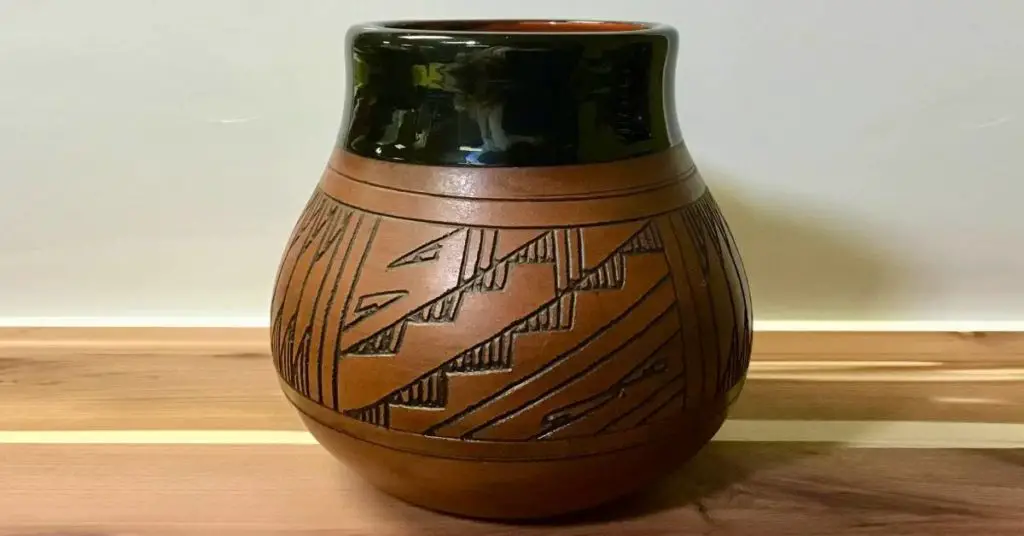
The pictured piece is by artist Taipei Navajo. The finish is similar to dark wood carvings with incised petroglyphs in black.
Petroglyphs are images that are engraved or scoured on a rock surface. Petroglyphs were typically used to mark down scenes, tell stories, or beautify a wall or work of art. There is canyon called Crow Canyon filled with Navajo petroglyphs in Farmington, New Mexico. The walls of the canyon have human figures, animals, and scenes of harvest etched into the walls.
6. Navajo Etched Wildlife Pottery Plate
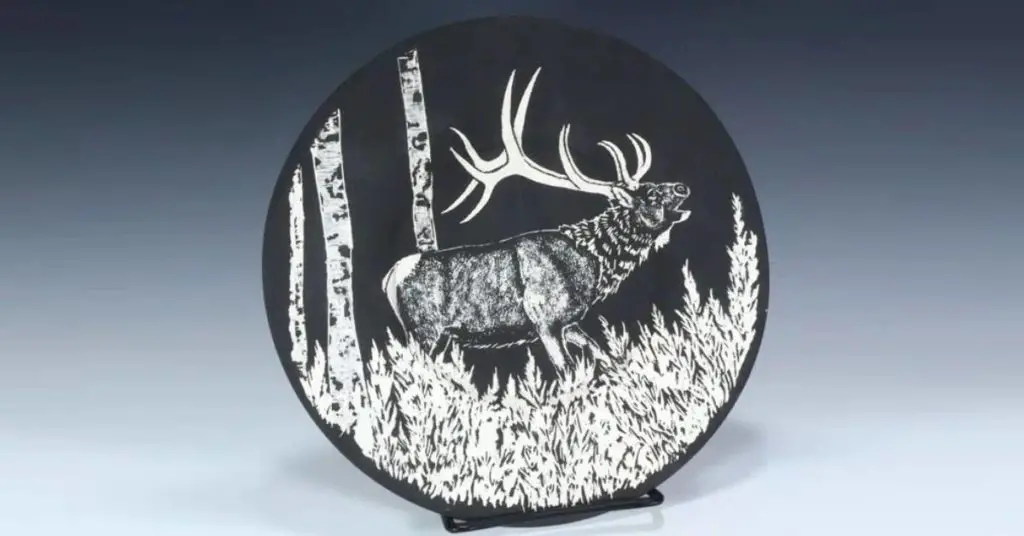
The piece above is by Frank Lee, a Navajo potter.
Lee created the plate from a cast mold. Then painted it black and etched the beautiful wildlife landscape. The stark color contrast is similar to traditional methods used by Acoma Pueblo potters. The Pueblo’s are the Navajo’s neighbors and many of the pottery styles derive from Native American Pueblo Pottery.
Molds are most commonly used with clay slip. You can learn more about molds in our a article What is clay slip in pottery?
7. Navajo Etched Wildlife Pottery Pillow Pot
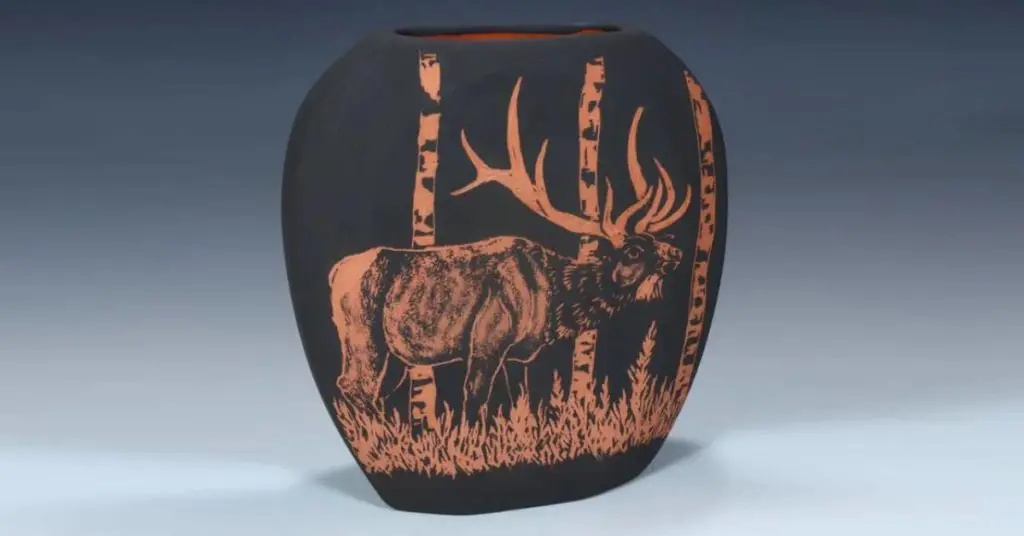
This piece is also from potter Frank Lee (same as #5). Similarly, Lee used a cast mold to pour this pillow pot. He then painted etched the pattern (it’s very similar to the Greek’s black-figure pottery).
You may be wondering why I would include a piece in the list so similar to the last. Well, I’m glad you asked. The color is super different. In this piece artist Frank Lee used a different clay type. So when he painted and etched the piece, he reveal the terracotta coloring of this clay (the other had a gray or stone like coloring to it).
Another common way people (i.e. the Santo Domingo Pueblo tribe) from this region decorated pots was through painting on the design. Potters would use the negative space to draw out decorations on a yellow-ish or white background.
8. Navajo Eagle Hand Etched Pottery
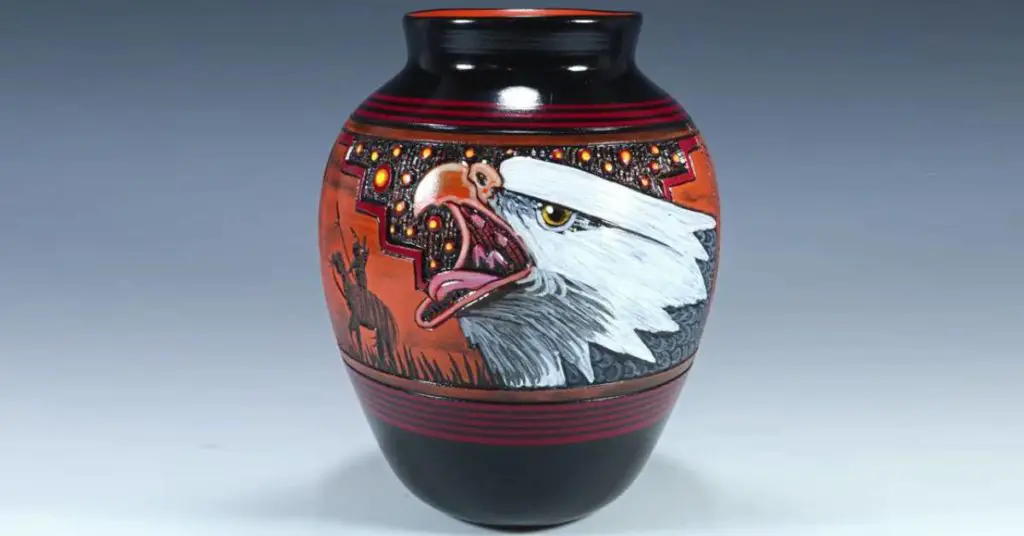
The artist, Paul Lansing, is a Navajo artist. In his featured work, he’s etched many symbols of the Navajo Indians with an eagle prominently feature. Eagles in the Navajo tradition hold eagles and eagle feathers as sacred. In its spiritual tradition, an eagle can fly up into the heavens delivering prayers to the heavens.
Check out more from the artist, Paul Lansing, at this link.
9. Navajo Horse Hair Ceramic Bear Figurine
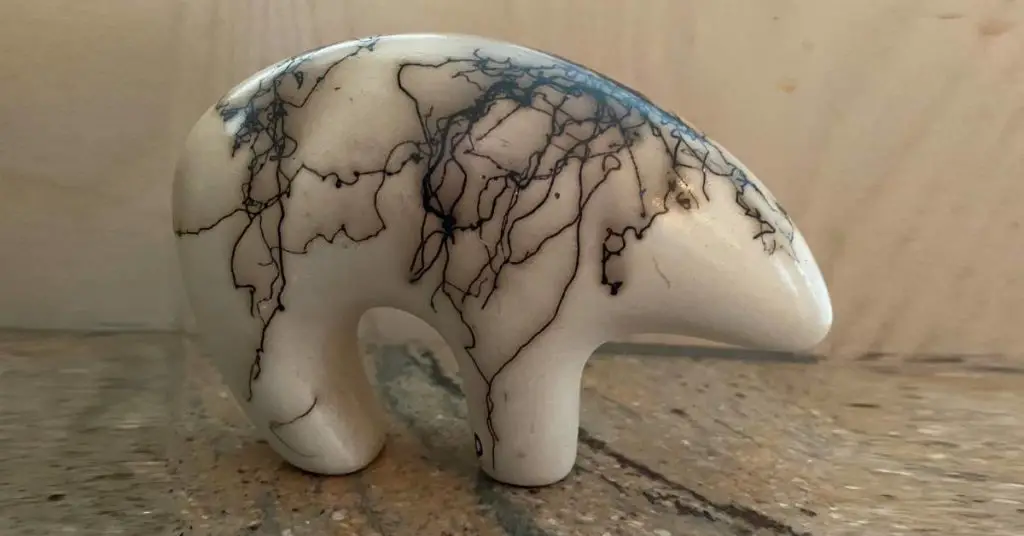
Here’s another example of horse hair ceramic art. Go back to #1 from this list to learn more about the process the Navajo potter walked through to get the cool design. The black markings on this piece is where the horsehair was added before the ceramic clay pot was fired.
Native American artists from a wide range of tribes are known for creating ceramic figurines. In our article all about Pueblo pottery, we shared how figurines were cultural storytellers depicting scenes both humous and somber.
A brief history of the Navajo people
The first Navajo people lived in western Canada approximately 1,000 years ago. They belonged to an ancient people called the Athapaskans. The Athapaskans are a group of tribes now found in Alaska and northern Canada. The Athapaskans referred to themselves as Dine or “the people”.
Groups from the “Dine” migrated south. Many archeologists believe the historic route the migrants took into the continental United States was along the Pacific Ocean. Some of the migrants settled there permanently. There are still descendants living along the Northwest Coast that originated from the migration.
Eventually, around 1300 A.D., bands of the Athapaskans settled in the Southwest where the modern Navajo Nation can be found today in northern Arizona, New Mexico, southern Colorado, and Utah.
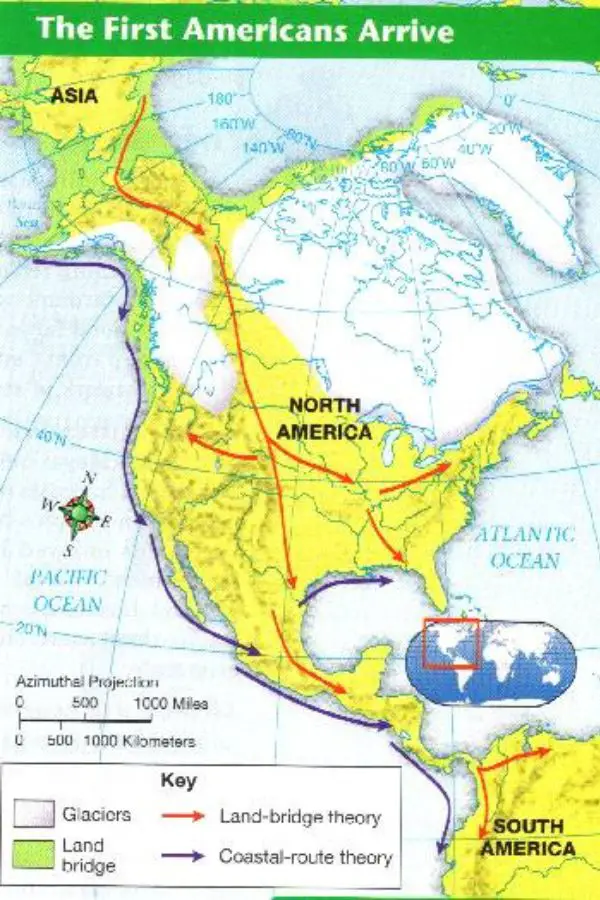
The nomadic Navajo Nation learned much from their Puebloan neighbors becoming farmers and developing a reputation as artisans. Their most celebrated works were made by Navajo potters. Similar to the Pueblo pottery tradition, Navajo women were the chief pottery makers. The craft was passed from one generation of women to the next.
The tribes originating from the Athapaskans people came into contact with Spanish missionaries who gave them the name, Navajo. The name Navajo loosely translated to “farm fields in the valley” as the Navajo culture reflected its neighboring Puebloan people’s practice of agrarian life.
The Navajo people wared with the Spaniards in Mexico and the new American settlers in the territory of New Mexico. Eventually, the American military involved themselves in the fight. Because of the history between the Navajo people and white settlers, the American commander in charge took a scorched earth approach, brutalizing the Navajo people.
All of the fighting culminated in what is now infamously known as “The Long Walk”. The Navajo people – including the elderly, sick, and children – were marched hundreds of miles to Fort Sumner to surrender to the American forces stationed there. Those too slow to keep up with the pace were shot and killed by American soldiers.
The Navajo people suffered at Fort Sumner until General William Tecumseh Sherman arrived. He was appalled by the conditions and quickly worked to sign a treaty that created the Navajo reservation and gave the land back to the Navajo people.
Conclusion
Native American pottery is a large collection of many cultures across a large geography. The Navajo people are one part of the greater whole that makes up a beautiful tapestry of ceramics by Native Americans. Over time, the Navajo people have developed a beautiful tradition that mirrors the works of neighboring tribes like the Pueblo people, but with their own spin.
From the earliest type of Navajo pottery to the available works made today, we hope you enjoyed this brief exploration of Navajo pottery designs. If you have any questions, please let us know! Simple email hello@wheelandclay.com. We’ll get back to you as quickly as possible.
Related articles
Did you enjoy learning about the Navajo tribes through the lens of pottery? Good news! We have more articles like this on other cultures. Check them out at the links below.
A guide to ancestral Pueblo pottery
A guide to ancient Mayan pottery
A guide to ancient Aztec pottery
A guide to ancient Egyptian pottery

